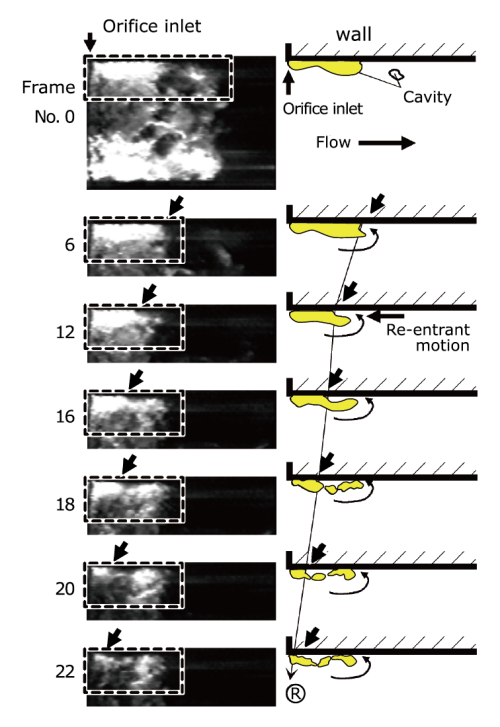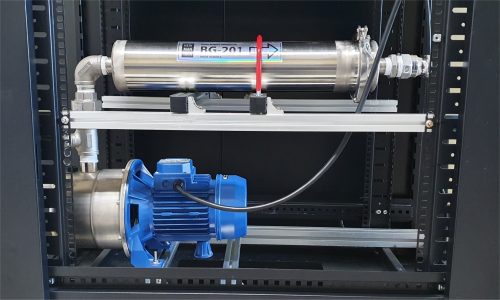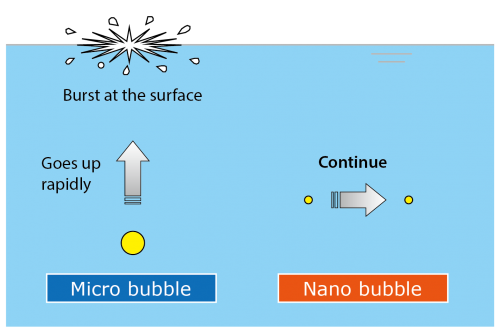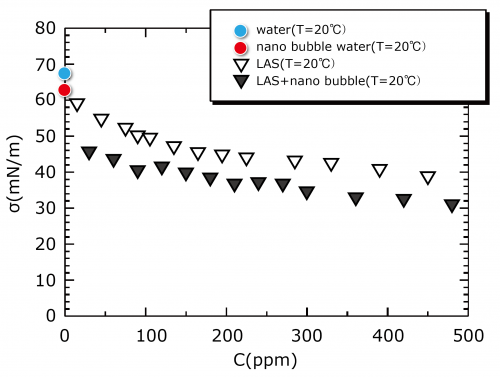■ Nanobubble technology
There are many techniques for generating microbubble. Microbubble technology requires a lot of energy and time to generate nano bubbles, which is not economical. The Newman Tech’s nanobubble generation technology is different from existing technology. It is the principle that the shear force is applied to the flowing gas-liquid mixture and it is split into bubbles. Specifically, when the gas-liquid mixture moves in contact with a specific surface, a velocity gradient occurs due to the boundary layer effect, and the gas-liquid mixture is continuously split to a nano bubble.

Generated Velocity gradient by shear force at interface

Splitted Bubbles by shear force
Our nanobubble device generates nanobubbles without recycling, and the bubble size averages 160nm.

Nanobubble generator (Q=3~20㎥/hr)

Nanobubble size & concentration
■ Nanobubble characteristic
Nanobubble is defined as diameters smaller than 1μm and larger than 1nm.
The smaller the bubble size slow floating, When it becomes nano-sized, it will not float and exist in the water.
As long as it exists in the water, it continuously delivers the substance in the bubble to the water.

Underwater behavior of nanobubble and microbubble
Nano bubbles reduce the surface tension of the bubble and water interface.
When nanobubbles are used with anionic surfactants, surface tension is further reduced.
Applying nano bubbles to cosmetics and pharmaceuticals using surfactants can reduce the adverse effects on the human body by reducing the amount of surfactant.

Effect of nanobubble on surface tension
Nanobubble characteristic test
Lab-scale nanobubble generator
Large capacity nanobubble generator
NanoBubble Q&A
■ What is nanobubble?
Nanobubble is a bubble with a diameter of less than 1 micrometer.
Nanobubble is also called “ultrafine bubble”.
■ What are the characteristics of nanobubbles?
Nanobubble is very small in diameter and floats very slowly.
The flotation velocity of the bubble can be calculated by Stoke’s Law, and when the bubble diameter is 100nm, the flotation velocity is very slow, less than 1mm/day.
Nanobubble has very high internal pressure.
The internal pressure of the bubble can be calculated by the Young–Laplace equation, and when the bubble diameter is 100nm, the internal pressure is 10 times higher than that of 1000nm.
When the internal pressure of the bubble is high, the solubility rate of the bubble gas increases.
The nanobubble is characterized by a very high rate of solubility of bubble gas due to its slow flotation velocity and high internal pressure.
■ How long do nanobubbles exist at atmospheric pressure?
At atmospheric pressure, the volume of the nanobubbles decreases over time, and some of the nanobubbles may exist for several months.
But when the volume of nanobubbles is reduced, the characteristics of nanobubbles disappear.
The volume reduction rate of nanobubbles is very fast at the beginning of generation, it is recommended to use nanobubbles within 24 hours after generation.
■ Do nanobubbles have oxidizing power?
No. Nanobubbles using air do not have sufficient oxidizing power.
To have oxidizing or sterilizing power, use ozone instead of air.
Some assume that oxidative power is generated by the explosive power of nanobubbles, but the explosive power is so insignificant that it is meaningless.
■ Are microbubbles and macrobubbles worthless?
No. Each bubble size has different uses.
Microbubbles have the advantage of being able to float suspended solid or oil.
Macrobubbles can circulate water.
Nanobubbles have a very slow flotation rate, so the nanobubble device cannot be used as a flotation device or circulation device.
Some companies use a nanobubble device as a flotation device, which is highly likely to be a microbubble device.
■ What is a nanobubble device?
It is a device that creates nano-sized bubbles in a liquid.
It is not a device that sprays only bubbles like an aerator, but a device that effluents the liquid in which nanobubbles exist.
■ Which gas is economical to use, air or oxygen to increase dissolved oxygen?
The proportion of oxygen in the air is 21% and the proportion of oxygen in the oxygen generator is 90%.If the amount of gas is the same, the oxygen in the oxygen generator is 4 times more.
The part that consumes high power based on my device is the pump, and the power consumption of the oxygen generator is 25% of that of the pump.
In other words, if 25% more power is used, dissolved oxygen can be increased 4 times.
Therefore, it is much more economical to use an oxygen generator than air.
■ Does dissolved oxygen increase as the diameter of nanobubbles decreases?
Yes. However, reducing the nanobubble diameter may not be economical.
A lot of energy is consumed to make the average diameter of nanobubbles less than 100nm.
But dissolved oxygen does not increase in proportion to the energy consumed.
Among the methods of increasing dissolved oxygen, it is more economical to increase the oxygen injection amount a little more than to make the nanobubbles small.
